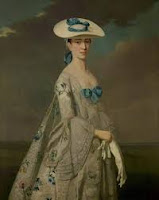18th Century
Women's Fashions
Women's Fashions
Hairstyles, Wigs and Hats
Hairstyles
"Ladies and gents alike achieved their fashionable pale hair colour by applying hair powder, which was made from flour or starch and puffed onto the head with a pair of bellows [a device constructed to furnish a strong blast of air]. For that typically Georgian ‘big haired’ look the wealthy employed an army of stylists who built elaborate structures atop their heads around wooden frames padded with extra sections often made from horse hair.
Curling tongs were also developed: these resembled a pair of blunt scissors, with two metal prongs and wooden handles. When the prongs were heated in the fire the hair could then be wrapped around them and held in place until the curl had set. Alternatively, clay rollers were heated in an oven and then applied to the hair or wig."
 |
| Bellows |
 |
Curling Tongs
|
 |
Clay Curlers and Curling Iron
|
Opinions differ on the use of wigs for women in the 18th century. Some say women didn't begin wearing them until the later part of the century. Others say they only wore them if they were trying to keep vermin out of their hair, or if they couldn't achieve a hairstyle they wanted with the hairstyling tools of the day. The paintings of early to mid 18th century, would suggest that wigs were worn early in the century, at least by some women and later in the century. Historians seem to agree that the wig began going out of style by the end of the century. When exactly wigs were worn by women is unclear (at least to me), but they were a part of 18th century fashion, even more for men than women. Women did wear them, though and so I'll share some of those styles with you.
Hats, Bonnets, Mob Caps...
"In the middle to late 18th century in England during the Georgian Period, married women wore head coverings called mob caps. These cloth coverings were made from linen, fit closely to the face, tied with a bow, and were open in the back to make room for pinned-up hair. They protected tresses from grime and were more convenient to wash than the hair itself. Worn only indoors, they were covered by structured bonnets when women went out in public."
"Straw hats were frequently worn in the mid-1700s and became immensely popular in the late 1700s. Women wore straw hats outside to shield themselves from the sun. The hats often had a flat brim and a ribbon. Straw hats were usually worn by women in the country and on farms, but they became more popular among city women in the 1700s. Hats were occasionally worn over caps.
Women of all social classes wore caps. Short of events requiring formal dress, caps were worn by 18th century women on a regular basis. Caps were generally white and made from linen. They were worn to promote cleanliness while being fashionable."
"The donning of the English bonnet, or ‘Bonnet du Jour’, did not depend upon a woman’s class; rather, it was enjoyed by everyone from milkmaids to maidens. The large brim framed the woman’s face but protected her profile from unwanted onlookers and lecherous men. The classic bonnet can often be seen in period works such as Jane Austen’s Pride and Prejudice."
I enjoyed the research for this subject, even though there are discrepancies in some of the data I found. In any case, I think I gave you a better idea of how an 18th century woman may have styled her hair or tried to and what types of head ware they may have worn. I didn't get into the fancier hats that would have been worn by the wealthy who attended court or more formal occasions, since that wasn't needed for my story. I also didn't show you some of the more outrageous hats. Many of those were inspired by Marie Antoinette, who hadn't yet been born in my time period. It's good for a laugh, though if you want to look it up yourself. 😀
If you were here last time, you probably expected to learn about shoes this time, but I just couldn't fit it in. Hopefully next time we'll get to look at the shoes of the day. If you are enjoying this series, I'd love to hear from you. Leave a comment and let me know if you've had a favorite part so far. Don't forget to subscribe and come again. I'm so grateful for my followers and I hope you'll join my tribe.
According to the Urban Dictionary:
" Tribe- A group of friends that becomes your family.
The people that will be there for you no matter what and who you're guaranteed to have a good time with."
Thanks for coming! May the Lord God bless you and your family with faith, hope and love, in Jesus' Name amen.
In Christ,
Sandy
SHARE this blog post!
COMMENT below!
and JOIN me next week!!




























